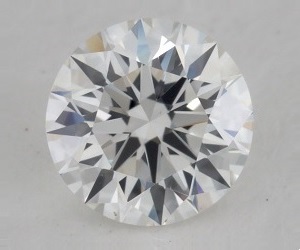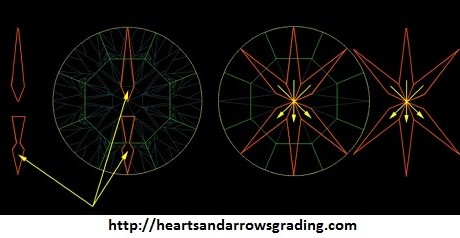Insights on Color They Didn’t Tell You
A comparison of D (colorless), H (near-colorless) and K (faint yellow) diamonds.
It is kind of counter-intuitive that diamonds are graded for the absence of color. In the industry, diamond color grading follows a D-Z alphabetical system. D, being colorless is the highest possible grade and Z, being light yellow is the lowest grade.
Technically speaking, the “best” grades would lie within the D-F colorless range with no discernible color. Colorless diamonds cost significantly more because they are rare in nature and are highly sought after by consumers in the market. In my opinion, you shouldn’t get too hung up on color as it is purely a matter of preference and personal tastes.
The truth is, the distinctions between color grades are so subtle that most people cannot tell the differences between them. Instead of buying a D color diamond, you could spend the same amount of money to purchase a bigger stone with a G color grade. Ultimately, if the diamond is well cut, it will still face up white and look beautiful to the eyes.
And if you like warmer colors, by all means, pick a diamond within the K-Z range. Not only will it give your ring a nice warm tint, you’ll find that it’s less stressful on the wallet too.

Take note: For bigger stones (> 1 carat), color would be more noticeable as their bodies tend to retain color. Also, the choice of ring setting might also affect the perceived color to our eyes. For example, a yellow gold setting would cause the diamond to pick up a yellowish tone from its surroundings.
Recommendations For People Who Are Averse to Color
> 1.50 carat weight: Choose a color grading of F or better
0.75 – 1.49 carat weight: Choose a color grading of G or better
0.50 – 0.74 carat weight: Choose a color grading of H or better
< 0.50 carat weight: Choose a color grading of I or better
To see side by side comparisons of various diamond colors, click this link.
Does Fluorescence Matter And How Does It Influence Color?

Diamond fluorescence gives off a cool glow in black light.
The most common color that diamonds can fluoresce with is blue and it can range from faint to very strong intensities. Perhaps of more importance is the knowledge that blue fluorescence can influence the overall color tone of the diamond.
This is because blue happens to be the complementary color of yellow and it can actually make yellowish diamonds look whiter. As a consumer, you can take advantage of this phenomenon by choosing to buy near colorless (G-J) diamonds with blue fluorescence.
The great thing about doing this is that you get to enjoy lower prices and get better value for your money.
On top of paying less for a near colorless (G-J) stone, diamonds with fluorescence are also cheaper (typically by 10-20%) due to market forces and demand.
When Can Fluorescence Negatively Affect a Diamond?
While fluorescence is a factor that is largely dependent on an individual’s taste, this intrinsic property may also work against you. You see, very strong fluorescence can cause a diamond to take on a milky appearance.
Sometimes, a consumer may come across a diamond that is selling at a hugely discounted price and a GIA grading report that seems to check out with no issues.
Thinking that they had just found a great deal, the unwary customer buys a diamond with very strong fluorescence. It is only later that they get a rude shock when they receive the package and notice a chalky appearance in the diamond.
The best course of action is always to double-check the stone’s physical outlook for any negative effects of fluorescence. If you are shopping in person, you could do this by doing side by side comparisons against diamonds without fluorescence.
If you are buying online, make sure you work with a trustworthy vendor and check if they can eyeball the stone on your behalf. Alternatively, you could also drop me an email or comment below if you need a second opinion of a diamond.


Both of these diamonds are D color, 1.50 carats, VS2 clarity. The one on the left has very strong fluorescence.
Can you notice that it is slightly hazy in appearance?
If you are intending to shop for a colorless (D-F) diamond, my advice is to stay away from those with strong/very strong fluorescence. In my experience, I noticed that a huge percentage of such stones (around 30%) display a certain degree of haziness in them.
Sometimes, the nuances may be subtle and will only be detected by a trained eye. At other times, the milky appearance may be more obvious (as in the case above). Either way, you don’t want to take your chances and end up with the possibility of getting a hazy stone.
Finally, I would like to introduce the 5th C, certificate, to you. When shopping for a diamond, I know just how easy it is to get confused by overbearing information and misleading sales pitches. However, one thing’s for sure, you want to make sure that the quality of the diamond is always accurately represented.
Find out more on the next page…














Leave A Comment